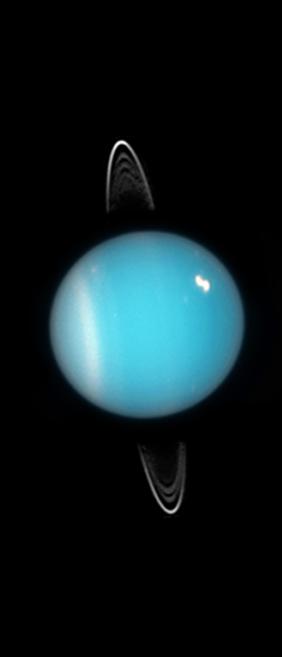Glossarbegriffe: Eisriese
Description: In unserem Sonnensystem gibt es vier Riesenplaneten: Jupiter, Saturn, Uranus und Neptun. Uranus und Neptun sind zusätzlich als Eisriesen bekannt. Sie haben einen festen Gesteinskern, der von einer dicken Schicht aus Wasser, Ammoniak und Methan umgeben ist. Diese chemischen Verbindungen befinden sich in einem merkwürdigen Aggregatzustand unter hohem Druck: Sie weder ganz fest noch ganz flüssig. Die äußere Atmosphäre beider Planeten besteht aus einer dicken, gasförmigen Schicht aus Wasserstoff und Helium.
Im frühen Sonnensystem war es in den äußeren Regionen weiter weg von der Sonne kalt genug, dass Wasser, Methan und Ammoniak zu Eis gefrieren konnten. Dabei ist "Eis" ein allgemeiner Begriff für gefrorene chemische Verbindungen, die aus Molekülen bestehen. Aufgrund ihrer Anziehungskraft haben die jungen Planeten Uranus und Neptun diese Eise angesammelt. Da sie einen so wichtigen Bestandteil dieser beiden Planeten bildeten, werden Uranus und Neptun als Eisriesen bezeichnet.
Zugehörige Glossarbegriffe:
See this term in other languages
Term and definition status: The original definition of this term in English have been approved by a research astronomer and a teacher The translation of this term and its definition is still awaiting approval
The OAE Multilingual Glossary is a project of the IAU Office of Astronomy for Education (OAE) in collaboration with the IAU Office of Astronomy Outreach (OAO). The terms and definitions were chosen, written and reviewed by a collective effort from the OAE, the OAE Centers and Nodes, the OAE National Astronomy Education Coordinators (NAECs) and other volunteers. You can find a full list of credits here. All glossary terms and their definitions are released under a Creative Commons CC BY-4.0 license and should be credited to "IAU OAE".
Zugehörige Medien
Uranus in natural colours
Bildnachweis: NASA/JPL-Caltech credit link
License: PD Public Domain icons
Uranus with rings
Bildnachweis: NASA, ESA, and M. Showalter (SETI Institute) credit link
License: PD Public Domain icons
Neptune
Bildnachweis: NASA / JPL / Voyager-ISS / Justin Cowart credit link
License: PD Public Domain icons











